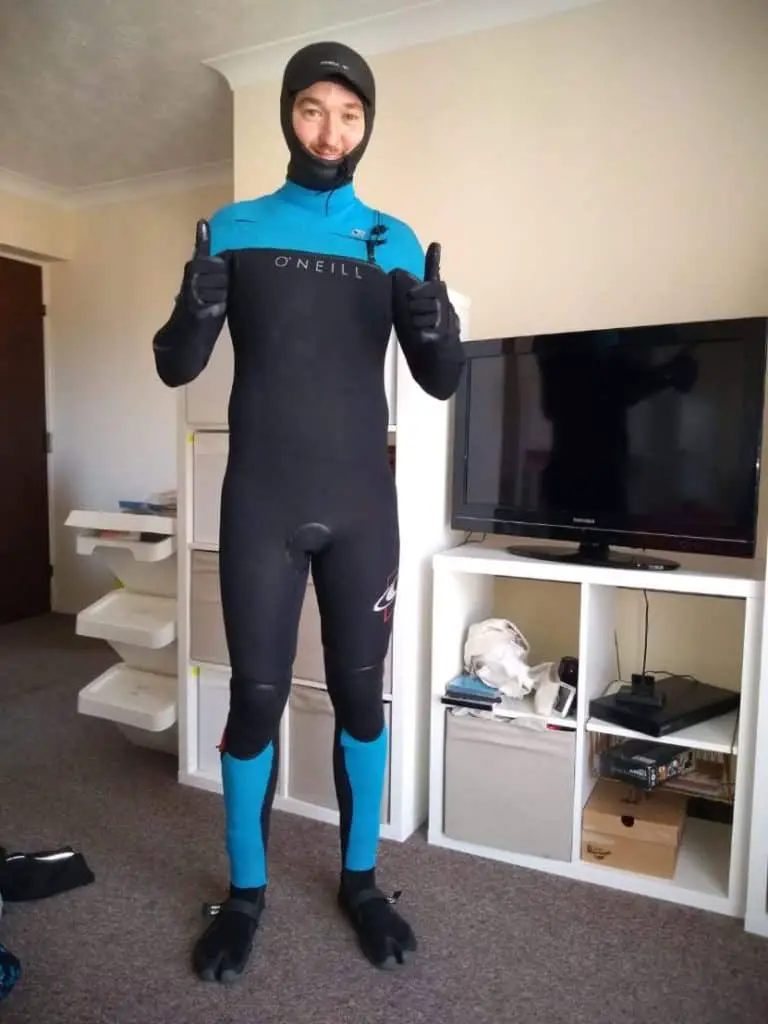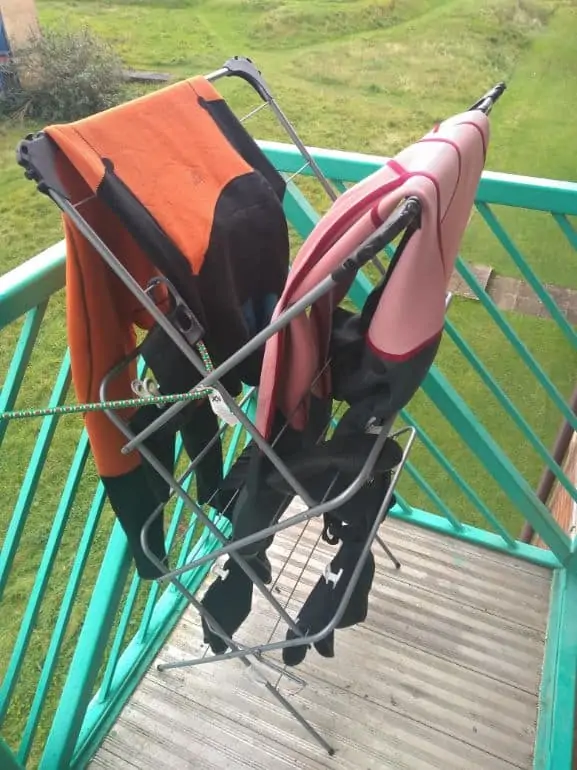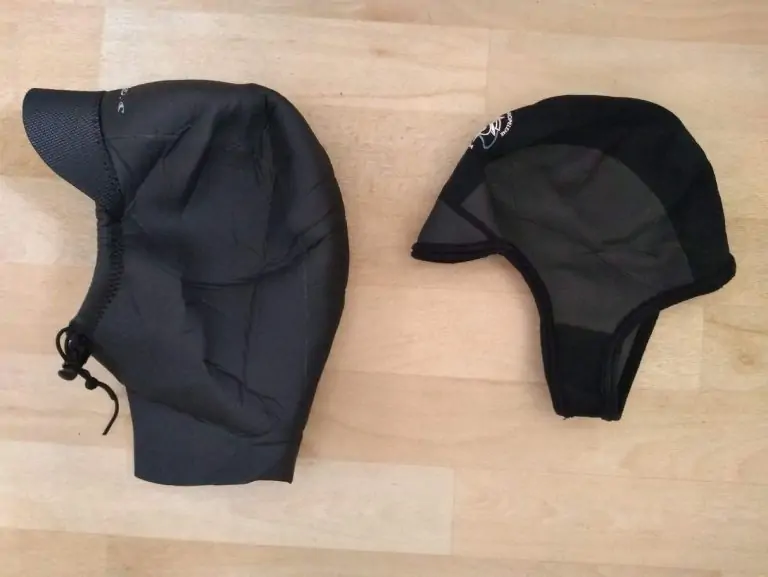How to Choose a Wetsuit for Surfing: 10 Tips to Get it RIGHT
To keep surfing all-year round in many parts of the world need a wetsuit.
Surf wetsuits seem simple at first but, once you start looking into them in a bit more detail, you will quickly find that there are many different designs, brands and features available, which can make picking the right first wetsuit a bit daunting.
So, to help you, here are 10 tips for how to choose a wetsuit for surfing:
- Chest zip all the way
- Think: location, location, location
- Be realistic
- Splash the cash
- Max out at 5mm
- Trust the brands (esp. cold water ones)
- Thermals top up
- Measure up
- Look around you!
- Taped Seams for Extra Steam
OK, so to help you get a clearer idea about each of the points above, let’s go into each one in more detail below to make sure that you get the right wetsuit for your surfing needs.
Without further ado, let’s get to it!
1. Chest Zip All the Way
A zip might sound like a small detail on a wetsuit but let me tell you a secret it took me years to learn: it’s probably one of the most overlooked parts of buying a wetsuit!
There are two main types of zips on surfing wetsuits:
- Back zips
- Chest zips
Back Zip Wetsuits
These are the standard offering when it comes to wetsuits and the most common; you will see them everywhere from surf schools to many surfers wearing them.
The zip runs down the middle of the back of the wetsuit and can be pulled up and down using the long cord/lanyard that comes with it.
Back zips are also the budget offering in terms of wetsuits, likely because they are easier to make than their chest zip counterpart.
However, they are not the best choice if you are going to be surfing in cold water since their design means that they let in a lot of cold water and tend to ‘flush’ when you go under the water, giving you a horrible ‘ice bucket challenge’ sensation each time. OK, so I might have been exaggerating on the last bit but back zip wetsuits do flush much more than chest zip equivalents, and are less comfortable, as will be explained below.
Chest Zip Wetsuits
So, the premium option in surf wetsuits is the chest-zip option, which is a big step up in when compared to back-zip wetsuits.
Surf wetsuits with a chest zip have a flat that you need to pull over your head to then connect the zipper.
The zipper runs across the chest horizontally, just below the collarbone.
Although these wetsuits are a little more tricky to do up when surfing alone, they are superior to back-zip wetsuits in a number of ways.
The first is in comfort. The placement and length of the chest zip make them much less noticeable than a back zip. Having a long zipper run the length of your spine is not a nice feeling since you will notice it when paddling and arching your back and head up.
The second is in warmth, as touched on above. While a back zip will flush and let in lots of water with just about every duck dive, a chest-zip wetsuit is much less prone to flushing.
This is because a chest zip is under your tucked head and chin, making it less exposed to the rush on an oncoming wave when compared to a back zip.
In addition, at the nape of the neck, a back-zip becomes a weak point, again on duck dives, since the zip closure means that it is slightly loose and therefore lets in more cold water.
The chest zip, on the other hand, has only tight neoprene in this location making the water run over it more freely and with its zip again being less exposed to the force of rushing water.
The last is by design; zippers let in water, as does the fabric around the zipper mechanism to attach it to a wetsuit. This is where chest zips have yet another advantage over back zips in that they are so much shorter in length, meaning that they a smaller surface area for this weak spot in wetsuit design.
Since chest-zip wetsuits let in less cold water and do not flush with cold water in the same way that back-zip wetsuits do, spending the extra amount on them is highly recommended if you plan to surf in an area with colder water and are looking at buying a winter wetsuit.
2. Think: Location, Location, Location
The next thing to consider is your chosen surfing location. You really want a wetsuit that works for you in as many months of the year in your chosen surf spots.
This means trying to get one suit that will keep you warm for as long as possible to save you buying more than one.
To help you, below is a table containing water temperatures for each surf wetsuit type and thickness:
| Water Temperature | Wetsuit Thickness (mm) and Type |
| >70°F | Boardshorts and possibly wetsuit top; i.e. no wetsuit needed! |
| 65-70°F | 3/2mm or 2mm wetsuit with short arms or legs |
| 60-65°F | 3/2mm full wetsuit |
| 55-60°F | 3/2 mm full wetsuit (Boots optional) |
| 50-55°F | 4/3mm full wetsuit with boots |
| 45-50°F | 5/4mm full wetsuit with boots, gloves and a hood |
| <45°F | 6/5mm full wetsuit with boots, gloves, hood and thermals |
Check Your Temperature
To use this information properly, be sure to check the water temperature year-round for where you plan to surf as it will help you to get an idea of the type of wetsuit and thickness that you should be looking to buy.
It also should be used along with the information provided in the following section of this article.

3. Be realistic
Although we all want to think that we could head out to surf in all weathers, the reality is that many of us will simply be put off by the frigid waters in the coldest months of the year.
If you live or plan to surf in an area where the water temperature gets below 55°F, then try to be realistic and think about how often you are likely to go surfing in those months of the year.
This reality check could be the difference between buying two mediocre wetsuits to be able to surf all year round and buying one excellent wetsuit that might only cover you for 9-10 months of the year but that you know will be top quality.
From my own experience, I’d also suggest that you might not want to go surfing in the coldest months of the year in the first year or two of surfing as it is hard and comes with its own challenges, so if you are at all unsure, then go for one premium wetsuit for the warmer months of the year. You can always get another one later on!
4. Splash the Cash
Now hopefully you’ve already seen and taken in the points above about being realistic before reading this (if not, skip back up and read that first!)
So, once you have made a good assessment of the amount of time you expect to be in the surf in your chosen wetsuit, you can then look into getting just one premium wetsuit that will cover you for most months of the year.
I recommend a premium wetsuit here because the difference between poor-quality budget wetsuits and high-quality ones will make a huge difference to your surfing experience each and every time you use.
As mentioned above, a chest-zip option is the best for reasons of warmth, comfort and design.
Remember that surf wetsuits are not cheap but that is because they are highly engineered to try and keep you warm in the sea for several hours at a time, which in itself is pretty incredible!
With that in mind, I’d also recommend that you choose a surf wetsuit made by a well-known surf brand; the reasons for which we’ll look at next.
5. Max Out at 5mm
If you’re in one of the colder parts of the surfing planet, then the chances are that you will want to max out with a wetsuit thickness of 5mm in your first few years of surfing.
As mentioned above, surfing in cold water is a chastening experience that can take years to get used to.
Added to that, a 6mm wetsuit is incredibly thick, cumbersome and hard to surf in. This means it can be like learning to surf all over again to use one of these wetsuits and that they are not best suited to new or less experienced surfers.
However, there is a way around that, as will be explained in the next section of this article.
6. Trust the Brands
Surf wetsuits are extremely specific types of gear and have improved dramatically in quality and design over the last 50+ years.
As such, if you are going to be surfing regularly, it is recommended that you get a wetsuit by a well-known surf brand.
This is not anything to do with fashion, rather because wetsuits are an essential piece of kit that you will need and that will help you to stay out in the surf for longer and in greater comfort.
So, the main surfing wetsuit brands to look out for are as follows:
- O’Neill
- Xcel
- Patagonia
- Rip Curl
- Vissla
There are lots of different wetsuits to choose from the brands above but, using the temperature guide provided here and the equivalent guides on their websites should help you to pick out one for you.
Remember also that you should find one brand that suits your body shape well, but that is something that really comes down to trial and error. Once you do, you can then stick with that brand.
As an extra tip, a friend once noted the following:
the best surf wetsuit companies usually originate in cold water areas (O’Neill and Xcel from Santa Cruz, California, with Rip Curl from Victoria, Australia).
Although this is purely an observation, I have to say I would agree so far from my own experiences with the different wetsuit brands, so something extra there to think about.

So, next up we’ll look at getting the finer points of sizing your wetsuit and getting it right.
7. Measure up
To give you the best chance of getting the right wetsuit for you, you should measure up all the relevant parts of your body, much in the same way that you would for a tailor or a dressmaker.
The main sizes you’ll need to know for sizing a surf wetsuit are:
- Height (feet and inches)
- Weight (lbs)
- Chest (inches)
- Waist (inches)
Please note that the measurements above are given in the format most commonly used by surf wetsuit manufacturers.
Since many of these are from the USA or Australia, imperial measurements are the norm, although you may find some wetsuit companies that provide metric equivalents in their sizing guides.
If in doubt, go local
However, if you look at a sizing chart for a surf wetsuit and you are in between different sizes, it’s recommended that you don’t buy your first proper surf wetsuit online: much better would be to go to a local shop and try one on first.
I say this because a wetsuit has a very specific fit and, depending on the other parts of your body, you may find that either going up or down a size benefits you.
Although I would usually suggest going for the smaller wetsuit, buying online would still be a bit of a risk so only do it if you have no local surf shops or if you are confident that the online retailer has a good enough returns policy.
This is where going into a physical store really does come into its own since you can ask the people in the store for their opinion on a wetsuit and for any tips on sizing, which is obviously something that almost impossible to get online.
Wetsuit Sizing Tip
One further point to note when trying to get the right size suit is that you don’t want to get a wetsuit that is too tight; this will make it difficult for you to breathe and move when you are out in the surf, which really won’t be nice or help with your surfing.
As such, remember that a surf wetsuit should be tight around your body, but not too tight around your neck or extremities.
You should be able to get an idea of what is too tight just from trying a wetsuit on in a store or at home before you take it out in the surf.
8. Top Up with Thermals
If you decide that going surfing in extremely cold weather is indeed something you want to do, then you should add an underlayer of thermals to keep you covered in the most extreme months of the year.
A thermal rash guard and shorts are a great start as they add lots of extra warmth and do not cost that much.
You can also go for a thermal rash guard with a hood as these help to reduce cold water getting into your suit from flushing and also to avoid exposing skin around your neck to the cold water when wearing the hood.
These thermals are also a great way to add extra warmth without having to go for the ultra-thick 6mm wetsuit option, so look carefully at the recommended temperature range for your location and desired wetsuits and see if you can factor these in.
Furthermore, if you are planning to surf in slightly warmer waters with in-between temperature ranges for a 4/3mm and a 5/4mm wetsuit then I would again recommend going for the thinner 4/3mm wetsuit and topping up with thermal layers under your suit.
If you are not sure exactly what you should be wearing, check out this dedicated post on what to wear under your wetsuit for both men and women in all temperatures.
9. Look around you
Although the main surf brands for wetsuits are outlined above, you can also take some inspiration and assurance from what the local wear at your nearest surf spots.
By looking around you and paying attention to what they are wearing and what is going on, you will be able to see just how many are wearing a certain brand.
You might want to pay extra special attention to the surfers who are there most often as they will be looking for the best gear to keep them in the water longest, be they the ones who spend hours in the water or those who are simply very good surfers.
The only time the above might not apply is if a local surfer is sponsored since companies like Quiksilver have a reputation for making wetsuits that are simply not that durable, yet they sponsor many professional surfers around the world. Remember that for someone who gets wetsuits for free, durability is not a concern so don’t take too much notice of what wetsuit sponsored surfers wear.
10. Taped Seams for Extra Steam
As an extra design tip when choosing your surf wetsuit, especially if you will be surfing in water colder than 60°F, is to get a wetsuit with liquid taped seams.
This might sound like a strange concept but it is really quite simple, as will be explained for clarity.
On the seams of any given wetsuit, there is stitching to hold the different pieces of neoprene used together.
This stitching looks like many other types of stitches you will see in garments and is nothing out of the ordinary. However, having fabric stitches to join different pieces of the material allows for more water to rush into the suit.
Although water will usually run out of your wetsuit and stop it ballooning up massively, this still creates an unpleasant sensation, that of ‘flushing’, as mentioned in an earlier section of this article.
These bog-standard stitched wetsuit seams are therefore another weak point in wetsuit design and make for a less pleasant surfing experience. This again becomes more noticeable the colder the water gets.
However, on better quality wetsuits you will notice the addition of liquid-taped seams. This is a special liquidized rubber that is applied over the seams as part of the manufacturing process. The more expensive the suit, the more of the seams are taped.
It also something that wetsuit manufacturers have started to use more and more in the last few years since its benefits are numerous.
Surf wetsuits with liquid-taped seams will help to reduce water rushing into your suit since the liquid rubber used in them is waterproof and also covers up the weak point of the seam itself.
These wetsuits will also last longer since the liquid tape adds another type of bond to help keep the seams together. This is noteworthy since some older, heavily used wetsuits start to stretch and come apart at the seams with heavy use.
As such, a wetsuit with liquid-taped seams should last longer and keep you warmer in every session, which is great for having a long-lasting wetsuit in colder conditions.
Related Questions
Can you use a scuba wetsuit for surfing? No, you can’t. This is because a scuba wetsuit is made for a completely different purpose with different movements. Surf wetsuits are designed to allow dynamic movement in different directions, while scuba wetsuits are not.
The most obvious design differences between the two types of wetsuit will likely be around the arms and in the zipper.
Using a scuba wetsuit for surfing would lead to a lot of difficulty when paddling on a surfboard as the movement will be restricted, so best to buy a surf wetsuit specifically.
How to size a wetsuit for surfing? Measure your height, chest and waist, and also check your weight; these are then given in sizing guides by wetsuit companies. Check that you are in the middle of the ranges they give. If you are an in-between size, go to a store to buy to be sure of a good fit.





2 Comments
Comments are closed.